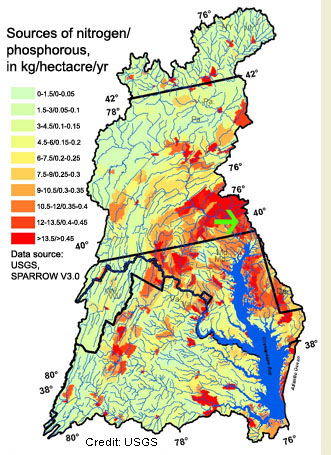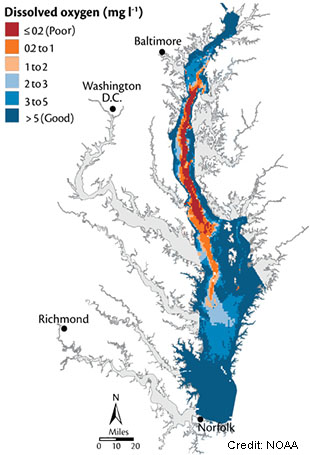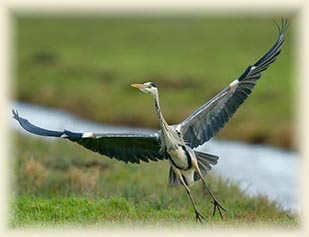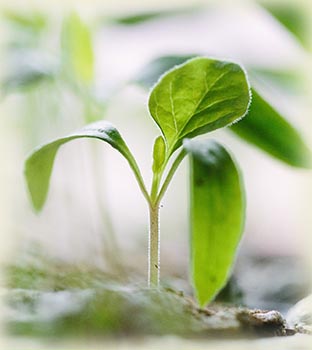
Historically, farming practices have damaged the environment by causing nutrient pollution, soil loss or destruction, and loss of habitat for native animal species. But times are changing. New techniques along with cultural mandates now enable farmers to minimize environmental damage and in some cases to attain a truly sustainable, carbon-neutral status. In our opinion, the new goal that is emerging is not to be just sustainable or to have a neutral environmental footprint but to go beyond sustainability. In other words, we want our farming practices to leave our farm and it's surrounding environment better than we found it. This goal is challenging but attainable. Below, we detail our efforts to reach this goal.
Our region's unique challenge: Nutrient pollution and the Chesapeake Bay
Farms are not isolated bodies but are connected to their surrounding areas by the movement of water, wind, animals and people.


Nutrients such as nitrogen and phosphorus are essential for the growth of all living organisms but excess nutrients are the primary pollutants damaging the Chesapeake Bay. The most serious is nitrogen pollution because it causes algae blooms. These algae blooms consume oxygen, thereby lowering dissolved oxygen levels so severely that fish and shellfish die. The blooms also block sunlight, which limits the growth of underwater plants. This leads to the "dead zones" that are observed in the Chesapeake Bay.
The sources of nitrogen and phosphorous reaching the Chesapeake Bay are mapped on the right. The green arrow indicates the location of our farm. Overall, agriculture is responsible for 38% of the nitrogen and 50% of the phosphorous reaching the bay. The other main sources are sewage treatment plants, residential and commercial lawn fertilizers, septic systems, and air pollution (from vehicle exhaust and industrial sources). Clearly, our location demands that we minimize nutrient pollutants that leave our farm.
How we control nutrient pollution
Pastured cattle: The biggest nutrient polluters within agriculture are concentrated animal feeding operations. These operations generate massive amounts of concentrated manure, store it in waste pits or lagoons, and often spread it on nearby fields. Manure is a useful fertilizer in soil, providing nutrients for plant growth. But when the concentration of manure exceeds the needs of growing plants, nutrient leaching into surface and groundwater occurs. In contrast, because livestock grown exclusively on pasture have a large area to roam (about 1 acre for each animal) their manure is well spread out, occurs slowly over time, and stays in balance with the growing grass in the pasture.
Stream bank protection: Pastured cattle have many environmental benefits but allowing cattle into creeks can negate these. We created a 150 foot wide stream protection buffer along the creek in our pastures. Cattle are excluded from this area by a half mile of fence that was recently installed. The buffer will be planted with trees next year to further protect the stream and its banks.
Composted manure: Cattle manure is a thick liquid that is typically pumped into storage pits and then periodically sprayed onto fields. In liquid manure, the majority of nitrogen and phosphorous is highly mobile (it volatilizes into the air and is easily transported by water movement). Furthermore, the nutrients in liquid manure are unavailable for plants until soil microbes have an opportunity to break them down. Mobile nutrients are easy to detect: They smell. Anytime you smell manure that means that mobile nutrients are being lost into the atmosphere. After an application of liquid manure, a rainfall can move over half of the nitrogen off the field and into nearby waterways.
A newer but more labor-intensive alternative, which we have chosen to use, is to compost manure. In areas where manure gets concentrated (in shady lounge areas of the pastures in summer and around hay feeders in winter) we maintain organic bedding (wood chips or straw). This organic bedding soaks up the liquid manure and its nutrients, holding them in place. Microbes then begin to break down the manure and bedding. This bedding is collected, allowed to "digest" for about a year with periodic mixing, and by the time it is applied to the fields the organic bedding and manure have been broken down into a black, rich, loamy compost. This compost contains the original nutrients from the manure but they are now in a form that is less mobile and is more available for plant growth. And it doesn't smell like manure; it smells like rich soil.
Manure application timing: In areas where we grow seasonal crops (e.g., corn, soybeans), our fields are never bare for more than a few days. Soon after harvest we plant cover crops (usually annual grasses such as barley or winter wheat). This allows us to apply composted manure in both the fall and spring onto growing crops, not bare fields. This ensures that the nutrients slowly released by the composted manure will be incorporated into growing plants and into the soil.
Diverse enterprises: Even if they grow all their own animal feed, dairy farms and concentrated animal feeding operations generate more manure than their fields and growing plants can absorb. If manure is applied faster than growing plants can incorporate it, the excess nutrients are deposited into the soil where they can move into surface and ground water. For this reason, "Beyond Sustainable" farming is not compatible with farms focused only livestock. A "Beyond Sustainable" farm needs to have other enterprises that utilize manure as a resource while not generating additional manure. This is where our apples and grain crops come in. By allowing us to spread our composted manure over areas not being used to feed livestock, we are spreading our manure out enough so that it does not overwhelm the growing plants capacity to absorb it.
How we improve the soil
Good soil is critical to any farm. But soil can be lost through erosion or damaged by compaction.
Growing grass is "Beyond Sustainable": An important component of soil is organic matter. Organic matter is composed of carbon-based molecules. Grass removes carbon dioxide (bad carbon; a greenhouse gas) from the air, incorporates it into organic molecules in the growing plant, and thereafter incorporated those organic molecules into the soil (when the plants or roots die or from manure). This process of "carbon sequestration" over decades is what turns the broken rock component of soil (e.g., sand, silt, clay) into a deep, rich soil capable of supporting lush plant growth.
Rotational "mob" grazing: "Mob" grazing means that a large number of cattle are allowed to graze a small piece of pasture for a short period of time. For example, a given piece of pasture is grazed for one day and then allowed to rest for 4-8 weeks. Soil can get compacted by constant exposure to cattle. Rest periods in between grazing allow the soil structure to recover. More importantly, mob grazing allows grass to fully regrow before it is grazed again. When mature grass is grazed, it's roots partially die back under the surface adding both organic matter to the soil as well as creating channels for water and air movement. Furthermore, mob grazing tramples some of the grass, causing it to die and be added to the soil. Rotational grazing also maintains a thick sod in the fields, stabilizing surface soil and preventing erosion. Overall, rotational mob grazing leads to a net accumulation of soil over time.

To convert the farm to rotational grazing, in the last 3 years we have installed 2 miles of underground pipe to provide water to 22 cattle watering stations. Each water station consists of a hydrant surrounded by a geotextile and gravel pad to prevent mud and soil erosion. In addition, we have installed over 5 miles of new fence to enable rotational grazing in small paddocks.
No-till farming: Traditional tillage methods of farming lead to a gradual loss of topsoil over time through wind and water erosion and by changing the soil chemistry through overexposure to oxygen. A new alternative is called "no-till farming." Under this system, weeds are most commonly controlled with herbicides (either traditional or organic). New options for weed control are flame weeding (which uses heat to lyse cells in plant leaves) and mechanical crushing. No-till farming preserves both the granular soil structure and earthworm channels, allowing better water absorption and proper soil aeration. Since crop residues are not tilled under but left on the surface, they protect the soil from erosion, conserve water and also provide cover and food for wildlife. But no-till is not perfect: it requires new and expensive equipment, especially seed drills that can plant through the remains of previous crops and it can reduce crop yields by 5-10%. For the past 3 years, our farm has been 100% no-till. This is a commitment we made and is a key step to achieving a "Beyond Sustainable" farm.

Winter cover crops: Although winter cropping is revenue neutral, it has multiple non-financial benefits. The cover crops protect the soil from erosion, they provide organic matter to help build up the soil, and they improve soil structure with their root channels. We use winter cover crops in all unplanted fields.
Sod spillways: Even though our no-till fields absorb water better than most, we still have some runoff after heavy rains. To prevent soil erosion, we have taken the areas most prone to runoff out of field crop production and converted them to permanent sod. This both stabilizes the soil from the moving water and helps to trap soil particles that have been picked up by moving water.
Windbreaks: We have planted over 5,500 trees and shrubs for windbreaks to minimize wind erosion. Each windbreak consists of two rows of trees and one row of shrubs.
How we improve the environment
Minimal chemical use: In some areas, such as organic apples, no chemicals are used. In other areas, while we are not organic certified, chemical use is greatly minimized. Our pastures haven't received a chemical application in over three years. Instead rotational grazing and mowing is used to control weeds.
Natural pest control: Flies can be a major irritant to cattle. Pesticides can be used but these also kill good bugs like dung beetle that help incorporate manure into the soil. The alternative is to use non-chemical methods. Sticky paper in areas where cattle congregate helps. But fly-eating birds are likely to be our best control strategy. In addition to the windbreak trees, we've planted over 2500 native shrubs alongside or within pastures to provide shelter and nest habitat for fly-eating birds. In addition, we are in the process of installing over a hundred birdhouses throughout the pastures.
How we benefit the community:
Teaching: We provide educational opportunities via several programs. Veterinary students from the University of Pennsylvania often work with our beef cattle as part of their large animal training. We also offer hands on training experiences with beef cattle for new ranchers or young adults interested in beef cattle. We have also had several visitors interested in viewing our various conservation efforts. We always welcome opportunities to teach and encourage conservation.
Research: We are proud to have donated small portions of our fields to Penn State for their study of groundwater movement. Such research will enable scientists to better understand the movement of nutrient contaminants into the ground and surface waters.